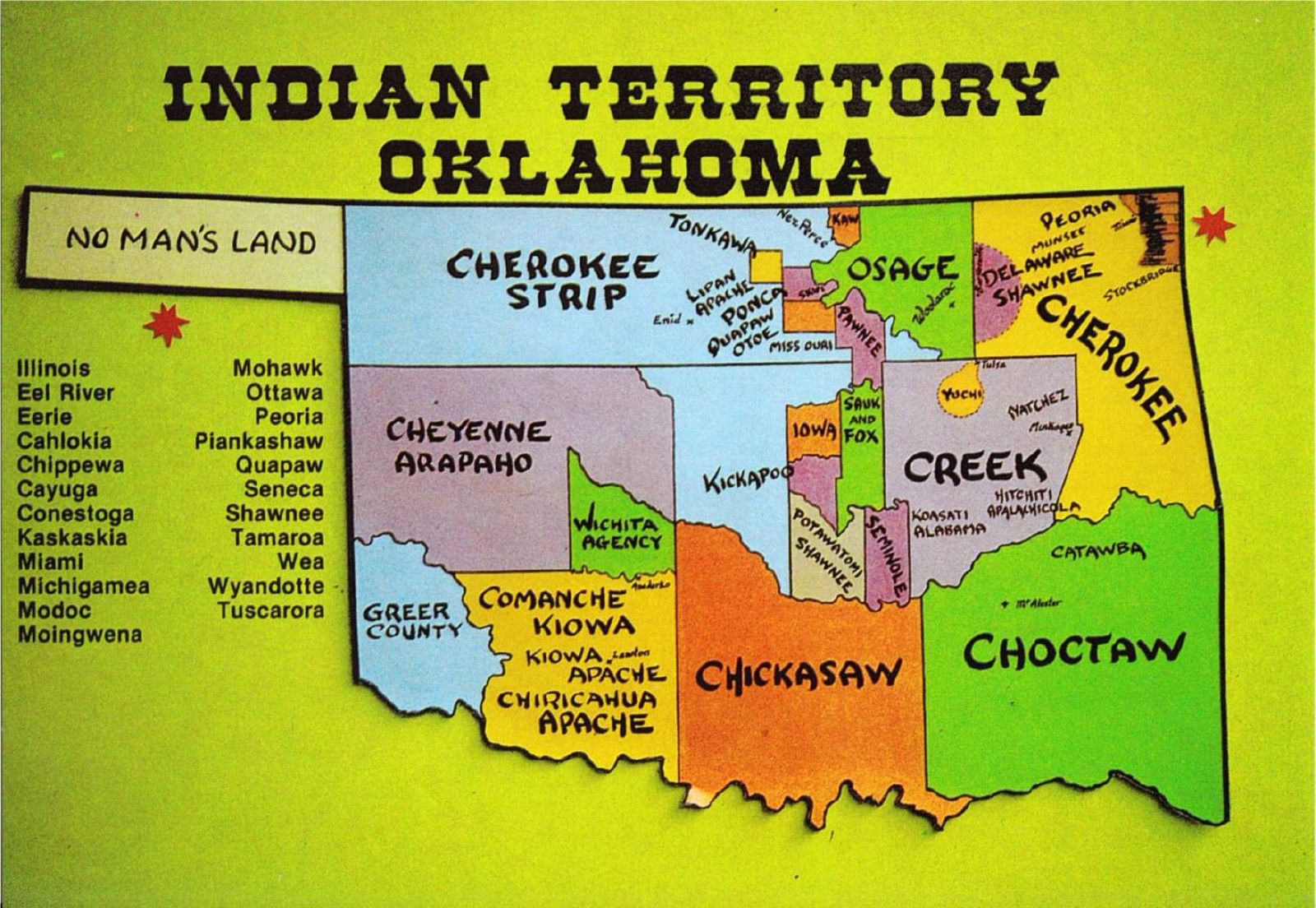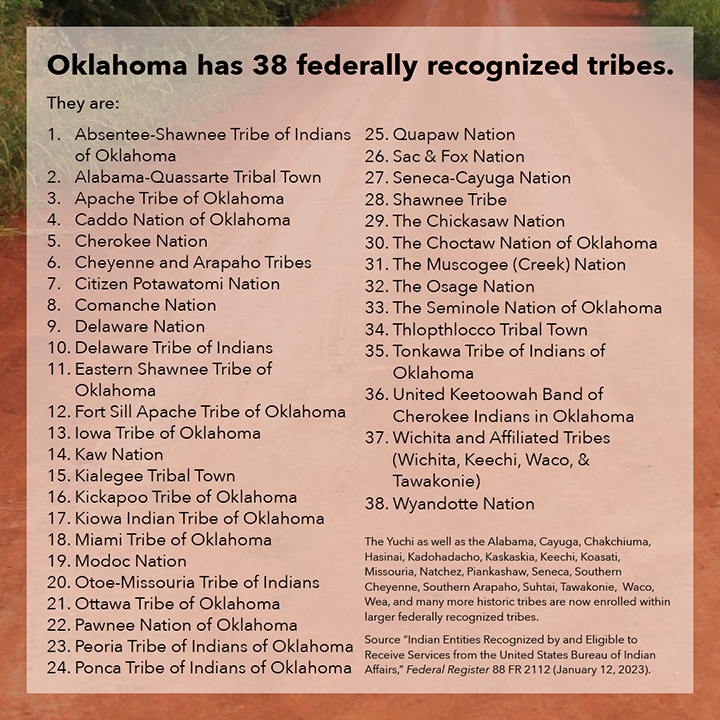Oklahoma: A Tapestry of Tribes – Exploring the Native American Heritage on the Land of the Red Earth
Oklahoma: A Tapestry of Tribes – Exploring the Native American Heritage on the Land of the Red Earth

Oklahoma, often referred to as the "Sooner State," is a land steeped in history, vibrant culture, and a rich tapestry of Native American heritage. From the rolling plains to the wooded hills, the state is home to 39 federally recognized tribes, each with its unique traditions, languages, and stories that have shaped the landscape and the lives of its people for centuries.
This article embarks on a journey through the diverse world of Oklahoma’s Native American tribes, exploring their history, culture, and contributions to the state’s identity. We will navigate through a map of the state, highlighting the locations of these vibrant communities and offering insights into their rich cultural heritage.
Related Articles: Oklahoma: A Tapestry of Tribes – Exploring the Native American Heritage on the Land of the Red Earth
- Unveiling the Wisdom of Elders: Empowering Native American Quotes
- Unveiling the Power: Navajo Bear Symbol Meaning- Unlocking the Mysteries
- Crow Guardians: Unleashing Native American Wisdom and Spirit
- Ojibwe’s Ancient Wisdom: Uncover the Tribe’s Enduring Customs
- Unraveling the Ancient Wisdom: A Journey into Crow Tribe’s Enduring Traditions
A Historical Journey: From Forced Removal to Resilience
The story of Oklahoma’s Native American tribes is intertwined with the tragic history of the "Trail of Tears," a forced removal of indigenous peoples from their ancestral lands in the Southeast. In the 1830s, the United States government enacted the Indian Removal Act, forcing thousands of Cherokee, Chickasaw, Choctaw, Creek, and Seminole people to relocate west of the Mississippi River.
This devastating journey, marked by disease, starvation, and hardship, resulted in the establishment of the Indian Territory, which later became the state of Oklahoma. Despite the trauma of forced relocation, these tribes persevered, rebuilding their lives and cultures on their new lands.
A Mosaic of Tribes: Diverse Cultures and Traditions
Oklahoma’s Native American tribes represent a remarkable diversity of languages, customs, and beliefs. Each tribe possesses a unique story, passed down through generations, reflecting their ancestral ties to the land and their resilience in the face of adversity.
The Five Civilized Tribes:
- Cherokee: Known for their written language, the Cherokee Nation is the largest tribe in Oklahoma, with a rich cultural heritage that includes storytelling, traditional dances, and crafts. The Cherokee Nation maintains its own government, judiciary, and educational system, demonstrating its commitment to self-determination.
- Chickasaw: The Chickasaw Nation is renowned for its contributions to art, music, and dance. Their traditional ceremonies, including the annual Chickasaw Summer Festival, showcase their vibrant culture and connect them to their ancestors.
- Choctaw: The Choctaw Nation is known for its strong emphasis on language preservation and cultural revitalization. The Choctaw language is a vital part of their identity, and they have established language immersion programs to ensure its continued existence.
- Creek: The Muscogee (Creek) Nation is known for its traditional dances, storytelling, and pottery. They are also renowned for their contributions to the state’s economy through their successful gaming operations.
- Seminole: The Seminole Nation is known for its unique cultural blend, influenced by their experiences in the Southeast and their resilience in the face of adversity. They are also known for their strong emphasis on self-governance and their commitment to preserving their traditions.


Other Notable Tribes:
- Comanche: The Comanche Nation, historically known as skilled horsemen and warriors, have a rich cultural heritage that includes storytelling, traditional dances, and beadwork.
- Osage: The Osage Nation is known for its strong cultural traditions, including their distinctive language and their role in the early oil boom in Oklahoma.
- Kiowa: The Kiowa Tribe is renowned for its artistic traditions, particularly their intricate beadwork and ceremonial dances.
- Pawnee: The Pawnee Nation is known for its unique cultural heritage, including their traditional earth lodge structures and their storytelling traditions.

A Map of Oklahoma’s Native American Tribes:
To truly appreciate the diversity of Oklahoma’s Native American tribes, it’s essential to understand their geographical distribution across the state. Here is a simplified map highlighting the locations of some of the major tribes:
[Insert Map of Oklahoma with Tribe Locations]
Cultural Preservation and Economic Development:
Oklahoma’s Native American tribes are actively engaged in preserving their cultural heritage and promoting economic development within their communities. They have established museums, cultural centers, and language immersion programs to ensure the continuity of their traditions.
Many tribes also operate successful gaming operations, contributing significantly to their economies and providing essential services to their citizens.
The Importance of Recognition and Respect:
It is crucial to recognize and respect the unique identities and contributions of Oklahoma’s Native American tribes. Their history, culture, and resilience are integral to the state’s identity and provide valuable insights into the complexities of American history.
Conclusion:
Oklahoma’s Native American tribes are a testament to the enduring spirit of resilience and the power of cultural preservation. Their rich history, diverse traditions, and ongoing contributions to the state’s economy and culture make them an integral part of the state’s identity.
By understanding and appreciating the stories of these tribes, we can foster a deeper understanding of the state’s past and present, and work towards a future that honors their heritage and celebrates their vibrant contributions to Oklahoma’s tapestry.
FAQ: Native Tribes in Oklahoma
1. How many federally recognized tribes are there in Oklahoma?
There are 39 federally recognized tribes in Oklahoma.
2. What are the Five Civilized Tribes?
The Five Civilized Tribes are the Cherokee, Chickasaw, Choctaw, Creek, and Seminole nations.
3. What is the Trail of Tears?
The Trail of Tears refers to the forced removal of Native Americans from their ancestral lands in the Southeast to Oklahoma in the 1830s.
4. What are some of the cultural contributions of Oklahoma’s Native American tribes?
Oklahoma’s Native American tribes have made significant contributions to art, music, dance, storytelling, language, and traditional crafts.
5. How are Native American tribes in Oklahoma involved in economic development?
Many tribes operate successful gaming operations, contributing to their economies and providing essential services to their citizens.
6. What can I do to learn more about Oklahoma’s Native American tribes?
Visit tribal museums and cultural centers, attend tribal events, and learn about their history, culture, and contributions through online resources and books.
7. How can I show respect for Native American tribes in Oklahoma?
Respect their cultural traditions, avoid using offensive language or stereotypes, and support their efforts to preserve their heritage.

Closure
Thus, we hope this article has provided valuable insights into Oklahoma: A Tapestry of Tribes – Exploring the Native American Heritage on the Land of the Red Earth. We hope you find this article informative and beneficial. See you in our next article!